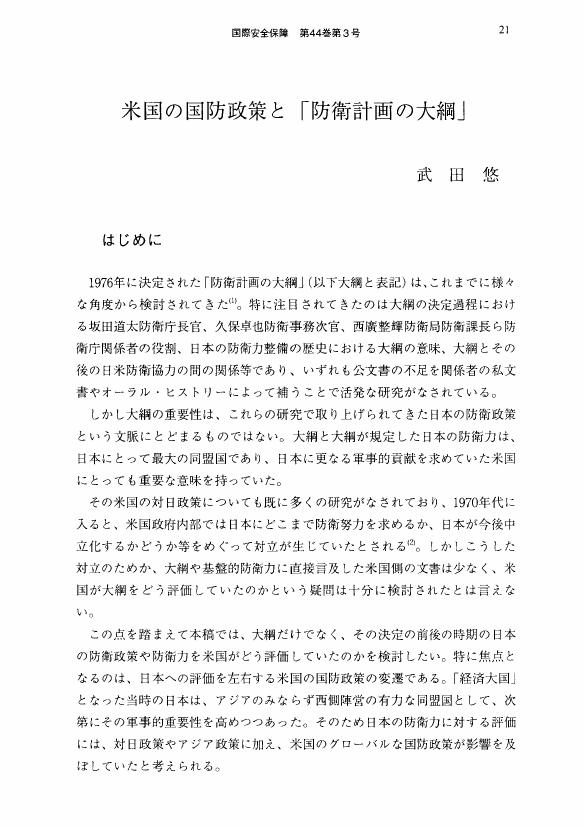12 0 0 0 IR 世紀転換期の出版文化と押川春浪 : 冒険小説の生成と受容
3 0 0 0 OA 世紀転換期の出版文化と押川春浪 : 冒険小説の生成と受容
3 0 0 0 OA 押川春浪『英雄小説 武侠の日本』の小説像 : 素材・構造・執筆動機を鍵として
- 著者
- 武田 悠希
- 出版者
- 日本近代文学会
- 雑誌
- 日本近代文学 (ISSN:05493749)
- 巻号頁・発行日
- vol.91, pp.1-16, 2014-11-15
本稿は、押川春浪の代表作とされる「海底軍艦」シリーズの論点となってきた「武侠」の定義が語られる『武侠の日本』を取り上げ、春浪が本作をどのように作り上げたのかを明らかにしようとするものである。特に、これまでの研究に欠けていた、春浪の創作態度を見るという視点を媒介させることによって、これまでの観念的に措定されたナショナリズムを指摘するにとどまる段階からの脱却をはかりたい。その際に手がかりとして、素材、構造、執筆動機を取り上げ、同時代言説との比較検証に留意することで、春浪が『武侠の日本』の創作にあたって、同時代の中での批判的意識を「面白さ」として加工し、それを小説という媒体に託すことを試みていたことを論証する。
2 0 0 0 OA 押川春浪『英雄小説 武侠の日本』の小説像 : 素材・構造・執筆動機を鍵として
- 著者
- 武田 悠希
- 出版者
- 日本近代文学会
- 雑誌
- 日本近代文学 (ISSN:05493749)
- 巻号頁・発行日
- vol.91, pp.1-16, 2014-11-15 (Released:2017-06-01)
本稿は、押川春浪の代表作とされる「海底軍艦」シリーズの論点となってきた「武侠」の定義が語られる『武侠の日本』を取り上げ、春浪が本作をどのように作り上げたのかを明らかにしようとするものである。特に、これまでの研究に欠けていた、春浪の創作態度を見るという視点を媒介させることによって、これまでの観念的に措定されたナショナリズムを指摘するにとどまる段階からの脱却をはかりたい。その際に手がかりとして、素材、構造、執筆動機を取り上げ、同時代言説との比較検証に留意することで、春浪が『武侠の日本』の創作にあたって、同時代の中での批判的意識を「面白さ」として加工し、それを小説という媒体に託すことを試みていたことを論証する。
2 0 0 0 OA 端末間無線通信を用いた多端末間コンテンツ共有ネットワークの構築
- 著者
- 武田 悠暉 山本 修平 西出 亮 高田 秀志
- 雑誌
- 第78回全国大会講演論文集
- 巻号頁・発行日
- vol.2016, no.1, pp.249-250, 2016-03-10
近年,携帯端末の普及によりゼミや会議など1つの場所に集まって多くの端末間でコンテンツを共有するような場面が増加している.このような場面において,ファイルサーバやクラウドストレージを用いる共有方法ではアクセスポイントにアクセスが集中して通信速度が低下する可能性がある.また,USBメモリや1対1の端末間共有を用いる方法では,共有のための操作を複数回行う必要がある.そこで,本研究では多くの端末間でコンテンツの共有を可能にするようなネットワークを,iOS端末を対象に,Multipeer Connectivityフレームワークの持つ様々な制約を考慮した上で実現する.
2 0 0 0 OA 日米関係の変容と原子力開発問題
- 著者
- 武田 悠
- 出版者
- 財団法人 日本国際政治学会
- 雑誌
- 国際政治 (ISSN:04542215)
- 巻号頁・発行日
- vol.2010, no.162, pp.162_130-142, 2010-12-10 (Released:2012-10-20)
- 参考文献数
- 70
The 1970s was an era of crisis and internationalization for Japan-U.S. relations. Both governments started to settle their bilateral conflicts for their policy cooperation which was required in the changing international environment at that time. To clarify the character of this change, this paper examines the bilateral negotiation of Tokai reprocessing plant held in 1977.In the late 1970s, the U.S. government attempted to rebuild international nuclear nonproliferation system by limiting peaceful nuclear power development such as spent nuclear fuel reprocessing technology. Carter administration took the office in 1977 and called its allies to stop reprocessing. However, Carter's new policy was highly problematic since reprocessing was a key technology in energy policies of other developed countries such as Japan. As Tokai reprocessing plant was planned to begin operation in 1977 and an approval from Washington was required for its operation, they need a settlement.At the first bilateral talk in April, Washington opposed firmly to the operation. On the other hand, international opposition grew rapidly against the new U.S. nuclear nonproliferation policy. Western European countries were especially sensitive to it since it could ban further export of nuclear-related technology to developing countries.Washington started to consider a compromise since Tokyo was the only close ally showing its approval to a framework of new nonproliferation policy. At the second meeting, the United States offered a proposal to alter Tokai plant more resistant to nuclear proliferation by technical modification. Although Japanese government opposed to the modification, they agreed to do a research about possible technical alternatives at Tokai Mura, Japan. As a result of this joint research and other investigations, however, Washington gave up all the technical solutions. Finally, at the third meeting at the end of August, Carter decided to permit the operation without any modification in return of Tokyo's agreement to reconsider reprocessing and suspend large scale Plutonium use for the moment.The above examination shows two aspects of the Japan-U.S. relations in the1970s. One is that Tokyo had an option to refine the U.S. foreign policy and participate in international politics by supporting Washington. In contrast to European countries that stopped the U.S. nonproliferation policy by refusing to cooperate, Japan did the same thing by aligning with the United States.The other is decreased importance of the bilateral relationship itself for the U.S. government, while Japan's substantive contribution to the U.S. foreign policy became a must to the United States. In sum, although both countries agreed to coordinate their policy objectives in the 1970s, this success became a basis of further bilateral conflicts on the way of implementing those goals.
1 0 0 0 OA 米国の国防政策と「防衛計画の大綱」
- 著者
- 武田 悠
- 出版者
- 国際安全保障学会
- 雑誌
- 国際安全保障 (ISSN:13467573)
- 巻号頁・発行日
- vol.44, no.3, pp.21-34, 2016-12-31 (Released:2022-04-01)
1 0 0 0 OA 吉田 真吾 著『日米同盟の制度化――発展と深化の歴史過程』
- 著者
- 武田 悠
- 出版者
- 国際安全保障学会
- 雑誌
- 国際安全保障 (ISSN:13467573)
- 巻号頁・発行日
- vol.41, no.3, pp.90-94, 2013-12-31 (Released:2022-04-07)
1 0 0 0 OA 新冷戦に向けた米軍事戦略と「同盟」国日本の役割 ―現場での協力と政治レベルでの摩擦―
- 著者
- 武田 悠
- 出版者
- 国際安全保障学会
- 雑誌
- 国際安全保障 (ISSN:13467573)
- 巻号頁・発行日
- vol.39, no.2, pp.64-77, 2011-09-30 (Released:2022-04-14)
1 0 0 0 OA 「日米防衛協力のための指針」策定をめぐる日米交渉 ―その意義と限界を中心に―
- 著者
- 武田 悠
- 出版者
- 国際安全保障学会
- 雑誌
- 国際安全保障 (ISSN:13467573)
- 巻号頁・発行日
- vol.36, no.4, pp.1-18, 2009-03-31 (Released:2022-04-20)
- 著者
- 武田 悠
- 出版者
- 広島市立大学
- 雑誌
- 研究活動スタート支援
- 巻号頁・発行日
- 2018-08-24
1978年の先進国首脳会議(サミット)において発出されたハイジャックに関する声明の形成と実施、及びそれらに対する日本の関与を、外交文書等に基づいて検討する。当時、西側世界有数の経済力を持つに至った日本は、経済問題のみならず政治問題でも国際秩序への関与を求められた。先進国が標的となっていたハイジャックもその最初期の事例であった。サミットを通じた日本の関与の実態を明らかにすることで、既存の国際秩序を受け入れて活動するのみだったと言われることの多い戦後日本外交が、実際にはその経済力ゆえに国際秩序の運営に関与していたことを明らかにする。
1 0 0 0 沈黙のアレゴリー : 『緋文字』における言語行為
- 著者
- 武田 悠一
- 出版者
- 一般財団法人 日本英文学会
- 雑誌
- 英文学研究
- 巻号頁・発行日
- vol.69, no.1, pp.63-76, 1992
- 著者
- 武田 悠
- 出版者
- 国際安全保障学会
- 雑誌
- 国際安全保障 (ISSN:13467573)
- 巻号頁・発行日
- vol.39, no.2, pp.64-77, 2011-09
1 0 0 0 福井辰彦編 『京都大学附属図書館蔵 菊池三溪自筆稿本目録』
- 著者
- 武田 悠希
- 出版者
- 立命館大学
- 雑誌
- 論究日本文學 (ISSN:02869489)
- 巻号頁・発行日
- vol.98, pp.104-104, 2013-05
1 0 0 0 OA 固形化栄養剤の消化管内形状変化と移行に関する研究-ラットを用いた基礎的検討-
- 著者
- 田代 勝文 東口 高志 武田 悠子 冨塚 利枝 藤瀬 暢彰 中村 強 升永 博明 伊藤 彰博
- 出版者
- 日本静脈経腸栄養学会
- 雑誌
- 静脈経腸栄養 (ISSN:13444980)
- 巻号頁・発行日
- vol.21, no.2, pp.2_115-2_125, 2006 (Released:2007-04-26)
- 参考文献数
- 27
- 被引用文献数
- 6
ペクチンにて固形化した栄養剤について、人工消化液による溶解性を検討するとともに、固形化栄養剤をラットの胃内に強制投与した場合の消化管内での形状変化とその移行、特に臨床上問題視されることが多い胃食道逆流や便性状に及ぼす影響に関して、基礎的研究を行った。溶解試験において、ペクチンを用いた固形化栄養剤は、寒天やゼラチンによる固形化栄養剤に比べ、人工胃液中では形状が維持され、人工腸液中ではゼラチンと同様に速やかに溶解することが認められた。また、ラットに胃内投与した場合、固形化栄養剤は液状栄養剤に比べ、胃内滞留時間を30分間程延長させたが、小腸内への移行後には投与栄養剤の物性の違いによる明らかな差は認められなかった。さらに、固形化栄養剤は液状栄養剤に比べ、口腔内逆流や食道内逆流を有意に抑制するとともに、下痢や軟便の発生頻度を有意に軽減することが認められた。以上の結果から、固形化栄養剤は液状栄養剤に比べ、胃内滞留時間を延長させるものの小腸内移行には影響を与えず、また胃内強制投与に伴って発生する胃食道逆流や下痢をいずれも抑制することが示唆された。





